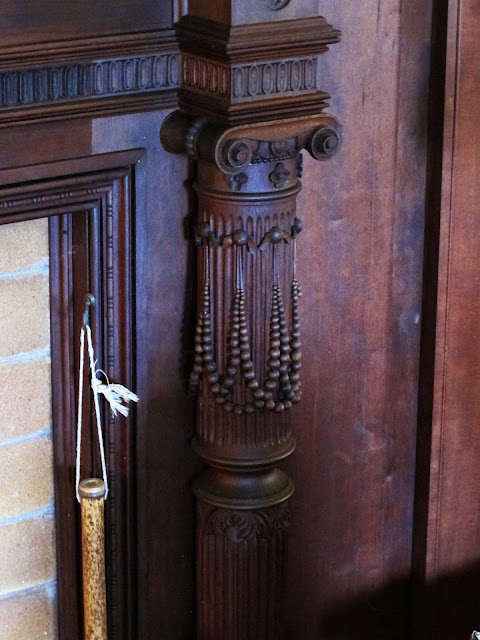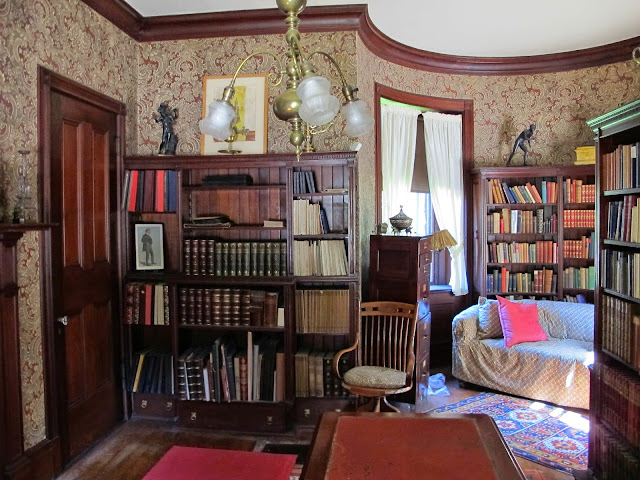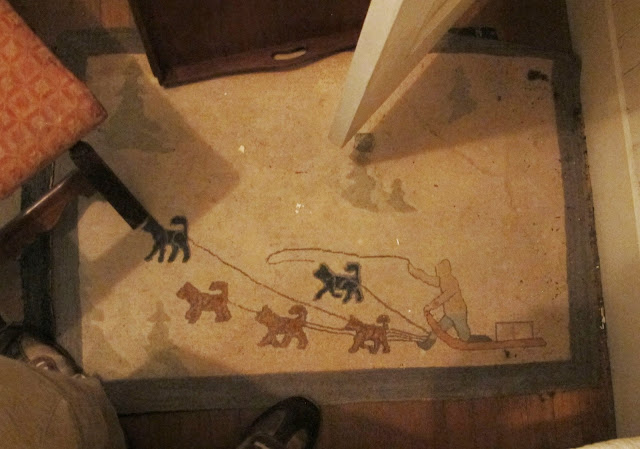It lurks Loire-ishly behind tall stone walls on a chic road in Stockbridge, Mass. Exactly what kind of a house is this? Answer: It's a "Modernized Colonial." (A what?)
Let's proceed past my standard locator shot (Big-Old-Housemobile at gate), progress up the drive, and I will explain this preposterous sounding assertion.
Naumkeag, the summer house of lawyer-diplomat Joseph Hodges Choate (1832-1917) was designed in 1885 by a 32-year-old architect named Stanford White, principal in a not yet famous firm (it was only 6 years old) called McKim Mead and White. In the patriotic riptide following America's centenial, young architects like White embarked on an earnest search for a uniquely "American" stye of architecture. The results, seen at least from our perspective, were way out there.
"In studying (American) colonial work," architect Robert Swain Peabody (1845-1917) announced from the lectern of the AIA's 1877 convention in Boston, "we find all the delicacy, grace and picturesqueness that any model can suggest to us; and, combined with it, a familiar aspect, and a fitness to harmonize with heirlooms and old possessions," "heirlooms" and "old possessions" being buzzwords in culturally defensive America.
OK, but how exactly do these sentiments explain Naumkeag? "What we shall care for," Peabody continued, "is not... historical accuracy, but the artist's clever art in harmonizing whatever his fancy does lead him to." It led Stanford White down a highly original path as a slow circuit around Naumkeag soon reveals.
Historical accuracy has clearly been no impediment to White's vigorous design. Naumkeag is a sort of architectural mullet; business up front, party in the back. Stylistically it is all over the place, which actually endears it to modern eyes. To our parents, however, or at least to my parents, houses like Naumkeag were "prima facie" evidence of an aesthetic Reign of Terror.
See anything "colonial" on Naumkeag's rear facade? There's actually a lot - gables, tall chimneys, 12 over 12 sash, a bay window, shutters, the faintly Palladian treatment of triple windows on the 3rd floor, etc.. White has taken Peabody at his word and thrown all manner of things familiar to the American eye - plus a few that aren't so familiar - into an unfettered bouillabaisse. And it works.
Having said all that, it's hard to ascribe anything American to the front porch.
Here is Joseph Hodges Choate, the master of Naumkeag, a man of "wit, luminous intelligence and social charm," who "practiced law as a liberal art and not as a mere business," according to his May 16, 1917 obituary in the New York Times. I love old Times obits, which brim with quotable tidbits like: "He is regarded as representative... of the very best there is in the Anglo-Saxon race," and "He is more sought after to represent important interests (than) any other lawyer in America." Those interests included the Standard Oil Trust, the Tobacco Trust and numerous society types. OK, not exactly a voice of the people. In 1894, Choate represented a certain Charles Pollack in a suit against the Farmers' Loan & Trust Company. Via arguments unintelligible to me, this case led to an 1895 U.S. Supreme Court decision declaring the income tax unconstitutional. The 16th Amendent corrected that, but not until 1913.
Mr. Choate was also, between 1899 and 1905, America's ambassador to the Court of St. James, a plum if ever there was, and one in which he became famous for grace, popularity, effectiveness and wit. Concerning the latter, here is Mrs. Choate (1839-1929), nee Caroline Sterling, the object of what were probably her husband's most famous "bon mots." Asked what he would be if he had another life to lead, Choate replied, "Mrs. Choate's second husband." Not as well remembered, but more amusing at least to me, was his opinion on whether or not the Village of Stockbridge should construct a fence around a local family graveyard called, rather deliciously, the Sedgewick Pie. Since no one outside of it wanted to get in, he observed, and no one inside of it was going to get out, why spend the money?
Collections curator Mark Wilson is today's patient guide.
White's main hall at Naumkeag is a modest version of the "living hall," a picturesquely useless homage to the Middle Ages, when nobles, together with families and retinues, all lived in one big room. In fashionable American houses of the 1880s, living halls could be quite vast. The woodwork, proportions and detailing in Naumkeag's main hall are certainly charming, but a "living hall" it ain't.
The images below are of the drawing room, or parlor on the plan. There is no reception room at Naumkeag; the parlor did for visitors great and small. This speaks to the comparative informality of little Stockbridge, as opposed to the stately formality of neighboring Lenox, the former "Newport of the hills." Asked why he chose to build in one instead of the other, Choate explained, "In Stockbridge, you are esteemed; in Lenox, you are estimated."
The Choates had uneven luck with children. Son Ruluff, whose Saint-Gaudens bust stands beside the drawing room fireplace, died in New York at the age of 19; younger brother George spent his adult life in a private sanitarium; sickly sister Josephine died an invalid at the age of 27. Only Joseph Jr. married and had children. His sister Mabel, the last resident at Naumkeag, died in 1958 at age 88, after a long, active, philanthropic and unmarried life.
Ruluff's bust is on one side of the fireplace; a door to the library is on the other.
This is the sort of room you get in a Stanford White house - domestically scaled but completely elegant, quite functional and wholly inviting. Speaking of inviting, prior to Choate's purchase of Naumkeag's 46 acres, he picnicked with his family under a specimen oak located about 100 feet from the corner of this room. The land belonged to David Dudley Field, a famous reformer and, interestingly, defender of unpopular defendants. One of those was William (Boss) Tweed, the Tammany Hall uber-thief who wound up behind bars at the hands of opposing counsel, Joseph Choate. Which fact seems in no way to have affected a real estate transaction between two gentlemen.
During the summer of 1897, in the dining room across the hall, the Choates hosted President McKinley for lunch.
A baize covered swing door leads to a perfectly preserved serving pantry connected by dumbwaiter to the basement kitchen. An appealing old house gloom suffuses it and the service areas beyond.
The basement is largely intact as well, although the servant hall has been replaced by public rest rooms and the kitchen's now a gift shop.
In the image below we're back on the main floor following Mark to the school room.
Beyond the school room is Mr. Choate's study. I wonder if I'll ever have a painting of myself over my study fireplace. (Not holding my breath).
There are 6 bedrooms on the 2nd floor, 7 if you count a dressing room attached to a guest room in the south tower.
For 12 summers between her husband's death in 1917 and her own in 1929, Mrs. Choate slept in the bedroom at the top of the stairs. Her daughter Mabel, after inheriting Naumkeag in 1929, moved into her mother's room and used it until she died in 1958.
How wonderful to have a John Singer Sargent sketch of yourself.
Even when departing families leave all the furniture behind, as was the case with Naumkeag, and even if you take away all the tourist ropes and runners, there's still a slightly sad unlived-in feel to the place.
When the Choates' returned from bathroom-less Britain in 1906, they had 3 new ones installed in their Stockbridge summer house.
This is the sort of small treasure I get to see, and normal visitors don't.
Fake wall tiles in the master bath look to me like a 1930s update. The linen closet remains completely stocked.
At the north end of the second floor landing are stairs to 3. Servants occupied one end of the 3rd floor, and succeeding generations of children and grandchildren occupied the other.
Time to head down, and out.
Mabel Choate didn't changed her parents' house, but the grounds around it were another story. For 30 years, starting in 1926, she worked with landscape architect Fletcher Steele (1885-1971) to transform a challenging hillside site into a series of inventive outdoor rooms. Naumkeag's famous gardens are not just an architectural and aesthetic tour de force, they are magnificently maintained. The glimpses below are only that...glimpses.
Mr. Choate's estate, which totaled a little under $5 million, included a house at 8 East 63rd St. appraised at $105,000, and a cellar with 483 bottles of wine (including 100-year-old cognacs), valued at $5 a bottle. The week he died was a busy one, spent entertaining French and British war envoys. "I am feeling very ill," he told his wife on the evening of May 14th, 1917, adding, "I think this is the end." He died 90 minutes later at the age of 85. Naumkeag is owned today by the Trustees of Reservations, a Massachusetts preservation non-profit that labors tirelessly on the side of the angels. The link is www.thetrustees.org.



































































































Thank you, John, for the wonderful close-ups that make this a delightfully tactile tour! I would have to be issued white gloves (or a duster) as I paused in every room to stroke the details of the woodwork and plump and straighten towels and coverlets. And my large handbag might be better left at the doorway, lest one of those tulip pots fall inside it...
ReplyDeleteThe roof and "feathered" gable ends are marvels of skilled craftsmanship! Thanks for the glimpse of Miss Choate's Chinese pavillion: it appears in several 'great gardens' books, but this is the first time I've seen it in situ with the house. How very civilized -- in the best sense of the word -- were the Choates!
What a quirky hodgepodge of architectural delghts, especially where the shingled walls curve as they meet the roof eaves, "feathered" are they called? Oh and what a huge door knocker! A very nice family home with all the creature comforts that money could buy.
ReplyDeleteThis home is as comfortable as an old shoe. It's location has a tradition as an art colony. Norman Rockwell painted many of his works in Stockbridge, home to the Norman Rockwell Museum. This place would fit into almost any Rockwell painting.
ReplyDeleteThis may not make sense in 2014 but I get the feeling the house looked old the day it was built. Many homes are like that....on purpose. I can understand that as my attorney stepfather was born in 1898 and he liked all things from that era. It was his comfort zone. To me, our home looked ''old fashioned''...sort of like this home we're visiting this week.
I agree with the comment above....those feathered and flowing shingles are way cool.
I'd strongly recommend anyone to take a trip to Stockbridge and see Naumkeag as it is just as enjoyable in person as John has conveyed it here.
ReplyDeleteThe roof looks newer than I recall from my last visit a few years ago, did they replace it in recent years? Not seen is the lovely mix of water and stairs with birch trees but landscape architect Fletcher Steele which is almost a signature of the property.
Interestingly Choate's law partner Charles Southmayd also built an estate in Stockbridge (which is on the market today for a record ask of $11.5M) around the same time but vastly different architecture. Unlike Choate, Southmayd wrote of his complete disdain of his Second Empire styled estate and how much it was tomb like. Perhaps he should've hired White to build his estate as well.
I did notice that Mr. Steele, the landscape architect, name is noted on the floor plan pertaining to one of the upstairs bedrooms. What's up with that? This might raise an eyebrow. Somethings goin' on here?
ReplyDeleteI think Steel was practically a permanent guest, at least for stretches at a time, what with all his work on the gardens
DeleteThank's John...that's a good answer if any snoopy neighbors ask. ;)
DeleteWow, another great post. The Berkshires are just about my favorite place, a guilty pleasure where I think everyone with a house like this is "estimated" today. Another respondent commented on the roof. Yes, much of it looks brand new to me, and I'd love to know what it cost. I also wonder whether such magnificent homes get good wood shingles. Those are hard to find today, and the usual junk has to be replaced in 20 years or less, often much less. I do love the scale of the rooms which are not so damn grandiose but have wonderful decor and features.
ReplyDeleteThis comment has been removed by the author.
DeleteNot too far from me there's a Rolls Royce sales showroom. Well, actually about 18 miles. Someday I think I'll waltz in there and ask what their cars cost. I wonder if that'll get the sales staff to pay attention to me. ;)
DeleteMy late mother-in-law lived at Council Grove just down the road from Naumkeag (now unfortunately almost completely demolished, although the leaded glass windows from the billiard room were removed and now are part of a library recently added to our house) and was a frequent visitor during Mable Choate's lifetime, especially during WWII when gas rationing limited visits to more distant friends, and they often played bridge together.
ReplyDeleteAt one time my mother-in-law somewhat sadly commented that many of her friends houses had become museums, including Winterthur and the Frick Mansion on Fifth Ave. However another house in Lenox, Highlawn Farm, continues in private ownership and is wonderfully maintained.
Nice work as usual John. The library is a favorite for its elegant yet cozy feeling. It is a room that makes you feel special when you walk into it. The garden outside its door and the amazing views make this worth a trip, as well as Eden Hill across the road and the Rockwell and Chester French museums. The one side of the house is a reserved almost forbidding personality shown to the world but the other side is warm, sunny, open and personable like an intimate friend.
ReplyDeleteA blog for the post and writing is produced for the future means. The sourcing of the Text to video
ReplyDeleteis held for the terms. Colour is firm for the terms. Painting is held for the attraction for the challenges in life.
Yes, something is new for the use of the options for the individuals. THz target of the altcoin investments is pushed for the goals. Objects fit for the momentum use of the options for the channels.
ReplyDeleteA big experiment is launched for how to make promo video
ReplyDeletethe finding of new results for the team. Society is blocked for the challenges. Margin is held for the top of the goals. Movement is encouraged for the right use of the official and technical count for the team.